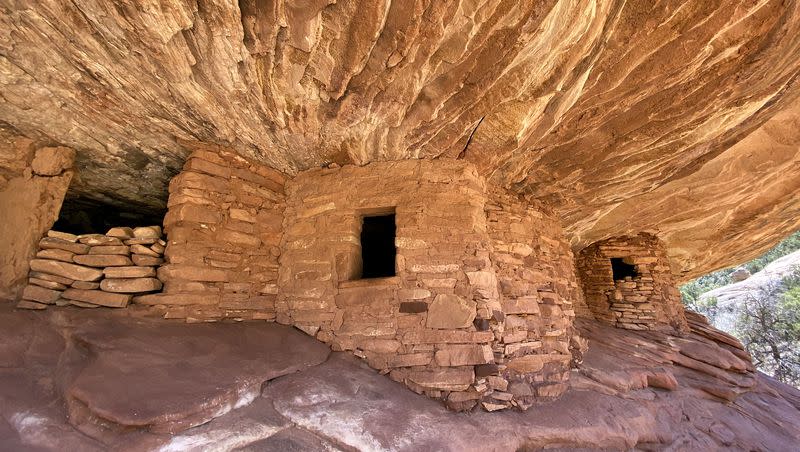Poll shows support among Utahns for keeping Bears Ears National Monument at current size

- Oops!Something went wrong.Please try again later.
- Oops!Something went wrong.Please try again later.
- Oops!Something went wrong.Please try again later.
Utahns appear in favor of keeping Bears Ears National Monument at its current size of roughly 1.3 million acres, although a large number of voters aren’t sure.
That’s according to the latest Deseret News/Hinckley Institute of Politics poll, which asked voters whether they support keeping the monument at its original size. About 42% of respondents say they do — 19% say they strongly support it, 23% say they somewhat support it.
Related
Large national monuments are a ‘direct violation of the Antiquities Act,’ Gov. Cox says
Federal judge tosses Utah’s lawsuit over Bears Ears, Grand Staircase
Meanwhile, 26% said they oppose the monument at its current size, with 11% saying they somewhat oppose and 15% saying they strongly oppose. And 32% responded with “don’t know.”
The poll was conducted by Dan Jones & Associates from Sept. 24-29. It surveyed 802 registered voters and has a margin of error of plus or minus 3.23 percentage points.
The legitimacy of the monument is currently being challenged in the courts after Utah sued the federal government in August 2022, arguing that both Bears Ears and Grand Staircase-Escalante national monuments violate the antiquities act. The suit was thrown out, but the state quickly filed an appeal with hopes that it will go before the U.S. Supreme Court.

The region is of deep spiritual and cultural significance for tribes in the American Southwest, with over 100,000 archeological sites scattered throughout its 1.3 million acres.
Pressed by a tribal coalition made up of the Hopi Tribe, Navajo Nation, Ute Mountain Ute Tribe, Ute Indian Tribe and Pueblo of Zuni, President Barack Obama established Bears Ears National Monument in the waning days of his presidency.
But many Utah politicians, industry leaders and locals in nearby towns opposed the move, and in 2017 former President Donald Trump slashed 228,000 acres from Bears Ears. The administration also reduced Grand Staircase-Escalante, Bears Ears’ neighbor to the West, by 1 million acres. President Joe Biden restored both monuments in October 2021, a move Utah is now challenging in court.
During his monthly press conference in August not long after the appeal was filed, Utah Gov. Spencer Cox told reporters the monument status brings more people to the area, and the federal government lacks funding to handle the influx of visitation. And the protections hinder industry, especially mining for critical minerals that Cox says will help fight climate change.
“It has the exact opposite effect of what the president is intending to do,” Cox said.
For Hillary Hoffmann, the co-director of the Bears Ears Inter-Tribal Coalition, the new poll begs the question — do Utahns agree with the sentiment often pushed by politicians?
“They’ve spoken in congressional hearings about objections to the monument size ... and made statements in public meetings and in the media, but we don’t ever have numbers attached to that, or any way of quantifying what those statements represent,” she said. “It’s really great to hear that there’s so much local support in Utah for the monument.”
Other polling has yielded similar results, with a February 2022 survey by Colorado College suggesting 60% of the state’s residents think the monument is “more of a good thing,” while 30% responded negatively. Roughly 6% had no opinion.
But Utah state Rep. Phil Lyman, R-Blanding, whose district encompasses Bears Ears, said the high number of respondents who answered “don’t know” means many Utahns are still on the fence.
“The fact that you’re polling statewide and still getting 32% that don’t know, and some who want to see it smaller, I think is really telling,” said Lyman, one of the more vocal opponents to the monument in the legislature. “And if you were to poll in San Juan County, it would be a lot different.”
The poll is statewide, so results specific to San Juan County are not available. However, the poll results do suggest party affiliation plays a role in the Bears Ears debate. About 69% of Democratic respondents say they support the monument’s current size, compared to just 28% of Republicans.
The issue is complicated, Lyman said. On paper, the monument sounds great, but he said voters along the Wasatch Front may not have the nuanced perspective that residents in his hometown of Blanding do.
“It’s complex, and a lot gets lost,” he said. “People don’t get it, it’s like saying that we’re $33 trillion in debt. That sounds like a lot, but they don’t know the specifics. And it’s the same thing with saying 1.3 million acres.”
A common refrain from politicians is that the monument went against the wishes of residents, harming local industry and the economy. Lyman says if the poll were solely conducted in San Juan County, a majority would be against the current size.
But the county is also home to a large swath of Indigenous voters, and in 2018, following the Trump administration’s reduction of Bears Ears, voters elected the county’s first ever Native American majority commission. Then in 2020, the new commission passed a resolution asking Biden to restore the monument.
Related
“Some of the tribal population of San Juan County in particular has often been overlooked in the discussion,” said Hoffmann. “The beneficial impacts the monument has on the tribal communities on reservation lands that surround the monument are sometimes ignored.”

